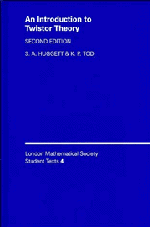Book contents
- Frontmatter
- Contents
- Preface
- Preface to the second edition
- 1 Introduction
- 2 Review of Tensor Algebra and Calculus
- 3 Lorentzian Spinors at a Point
- 4 Spinor Fields
- 5 Compactified Minkowski Space
- 6 The Geometry of Null Congruences
- 7 The Geometry of Twistor Space
- 8 Solving the Zero Rest Mass Equations I
- 9 Sheaf Cohomology and Free Fields
- 10 Solving the Zero Rest Mass Equations II
- 11 The Twisted Photon and Yang–Mills Constructions
- 12 The Non-Linear Graviton
- 13 Penrose's Quasi-Local Momentum and Angular Momentum
- 14 Functionals on Zero Rest Mass Fields
- 15 Further Developments and Conclusions
- 16 Hints, Solutions and Notes to the Exercises
- Appendix The GHP Equations
- Bibliography
- Index
15 - Further Developments and Conclusions
Published online by Cambridge University Press: 25 January 2010
- Frontmatter
- Contents
- Preface
- Preface to the second edition
- 1 Introduction
- 2 Review of Tensor Algebra and Calculus
- 3 Lorentzian Spinors at a Point
- 4 Spinor Fields
- 5 Compactified Minkowski Space
- 6 The Geometry of Null Congruences
- 7 The Geometry of Twistor Space
- 8 Solving the Zero Rest Mass Equations I
- 9 Sheaf Cohomology and Free Fields
- 10 Solving the Zero Rest Mass Equations II
- 11 The Twisted Photon and Yang–Mills Constructions
- 12 The Non-Linear Graviton
- 13 Penrose's Quasi-Local Momentum and Angular Momentum
- 14 Functionals on Zero Rest Mass Fields
- 15 Further Developments and Conclusions
- 16 Hints, Solutions and Notes to the Exercises
- Appendix The GHP Equations
- Bibliography
- Index
Summary
In this book, our aim has been to provide a brief introduction to twistor theory, sketching the mathematical background and indicating where it makes contact with the physics of space-time. It is possible to carry on from here in directions which we may characterise as inner or outer, and mathematical or physical.
By inner we mean developments which make rigorous and treat more thoroughly what has been treated informally here. For spinor theory the main reference is the two volume Spinors and space-time of Penrose and Rindler (1984, 1986). This is a mighty compendium of results for spinors in flat and curved space-time, and has more detail, in volume 2, on the quasi-local mass construction described in chapter 13. For more on sheaf cohomology and the twistor theory of massless fields and the active, curved-twistor-space constructions of chapter 11 see Twistor Geometry and Field Theory (Ward and Wells 1990).
By outer we mean developments that go beyond what has been covered here. Other parts of the theory of z.r.m. fields have been given a twistor description, and the formalism of chapters 8 to 10 has been much extended. Hyperfunction z.r.m. fields are discussed in Bailey et al. (1982) and fields with sources, which can be described by relative cohomology, by Bailey (1985). This material is reviewed in the article of Bailey and Singer in Bailey and Baston (1990).
- Type
- Chapter
- Information
- An Introduction to Twistor Theory , pp. 147 - 152Publisher: Cambridge University PressPrint publication year: 1994

